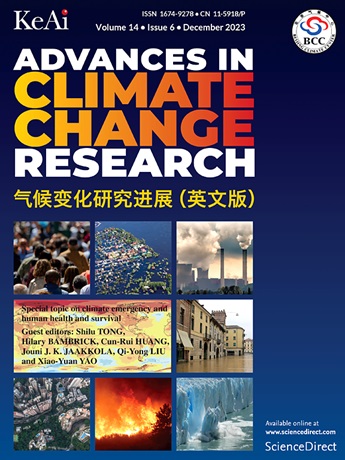An integrated modelling framework for evaluating the synergistic impacts of low-carbon transitions and air pollution controls on air quality and health in Guangzhou, China
IF 5.2
1区 地球科学
Q1 ENVIRONMENTAL SCIENCES
引用次数: 0
Abstract
Climate policies that target carbon emissions can induce co-benefits for air quality. Previous urban studies have typically focused on either carbon reduction or air pollution control independently, but few have examined their combined effects on reducing carbon emissions and consequential environmental gains. We develop an integrated modelling framework to assess the impacts of different low-carbon transitions and end-of-pipe controls on PM2.5 and ozone concentrations and associated premature mortality in the megacity of Guangzhou. The results show that the implementation of both deep carbon mitigation and aggressive air pollution control policies can reduce the city's pollutant emissions to 34%–51% of the 2020 levels by 2035. Consequently, the population-weighted PM2.5 concentration in 2035 is projected to decrease by 5 μg/m3 compared to the 2035 baseline scenario. However, the ozone concentration is expected to rise by 35 μg/m3 due to the reduced titration effect of NO on ozone. These changes are estimated to prevent approximately 3.0 thousand (95% CI: 2.0–3.9) PM2.5-related premature deaths, while increasing ozone-related premature deaths by approximately 1.6 thousand (95% CI: 0.7–2.7). Moreover, implementing multiregional integrated control measures in Guangzhou and its neighbouring cities yields greater air quality and health benefits for Guangzhou compared to local enforcement alone, resulting in 1.5 times more avoided PM2.5-related premature deaths. Additionally, the increase in ozone-related premature deaths from these cooperative emission control strategies is merely 0.3 times the figure observed under local enforcement alone. The transport and industry sectors play a crucial role in reducing air pollutant emissions, whereas reductions in the solvent use sector can help mitigate the adverse effects of reduced NOx on ozone pollution. These findings highlight the need for comprehensively multiregional strategies to balance the trade-offs between reducing PM2.5 and ozone-related health impacts, offering valuable insights for urban policy makers aiming to optimize both climate and air quality goals on a broader scale.
评估低碳转型和空气污染控制对中国广州空气质量和健康的协同影响的综合建模框架
以碳排放为目标的气候政策可以为空气质量带来协同效益。以前的城市研究通常只关注碳减排或空气污染控制,但很少有人研究它们对减少碳排放和相应的环境收益的综合影响。我们开发了一个综合模型框架,以评估广州特大城市不同的低碳转型和末端控制对PM2.5和臭氧浓度以及相关的过早死亡率的影响。结果表明,到2035年,实施深度碳减排和积极的大气污染控制政策可以将城市污染物排放量降低到2020年水平的34%-51%。因此,2035年人口加权PM2.5浓度预计将比2035年基线情景降低5 μg/m3。但由于NO对臭氧的滴定作用减弱,预计臭氧浓度将上升35 μg/m3。据估计,这些变化可预防约3000例(95%置信区间:2.0-3.9)与pm2.5相关的过早死亡,同时使与臭氧相关的过早死亡增加约1600例(95%置信区间:0.7-2.7)。此外,在广州及其邻近城市实施多区域综合控制措施,与仅在当地实施相比,为广州带来了更大的空气质量和健康效益,避免与pm2.5相关的过早死亡的人数增加了1.5倍。此外,这些合作排放控制战略造成的与臭氧有关的过早死亡的增加仅是单独在地方执法下观察到的数字的0.3倍。运输和工业部门在减少空气污染物排放方面发挥着至关重要的作用,而溶剂使用部门的减少可以帮助减轻氮氧化物减少对臭氧污染的不利影响。这些研究结果强调,需要制定全面的多区域战略,以平衡减少PM2.5和臭氧相关健康影响之间的权衡,为旨在在更大范围内优化气候和空气质量目标的城市决策者提供有价值的见解。
本文章由计算机程序翻译,如有差异,请以英文原文为准。
求助全文
约1分钟内获得全文
求助全文
来源期刊

Advances in Climate Change Research
Earth and Planetary Sciences-Atmospheric Science
CiteScore
9.80
自引率
4.10%
发文量
424
审稿时长
107 days
期刊介绍:
Advances in Climate Change Research publishes scientific research and analyses on climate change and the interactions of climate change with society. This journal encompasses basic science and economic, social, and policy research, including studies on mitigation and adaptation to climate change.
Advances in Climate Change Research attempts to promote research in climate change and provide an impetus for the application of research achievements in numerous aspects, such as socioeconomic sustainable development, responses to the adaptation and mitigation of climate change, diplomatic negotiations of climate and environment policies, and the protection and exploitation of natural resources.
 求助内容:
求助内容: 应助结果提醒方式:
应助结果提醒方式:


